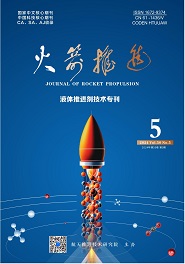航天推进技术研究院主办
WANG Darui,CHENG Shengqing,ZHANG Nan.Simplification for chemical reaction mechanism of liquid attitude and orbit control engine by PP method[J].Journal of Rocket Propulsion,2015,41(05):61-66.
利用PP法简化液体姿轨控发动机化学反应机理
- Title:
- Simplification for chemical reaction mechanism of liquid attitude and orbit control engine by PP method
- 关键词:
- 姿轨控发动机; 甲基肼/四氧化二氮; 简化机理; 主成分联合多代通量方法
- 分类号:
- V434.13-34
- 文献标志码:
- A
- 摘要:
- 针对含有43种组分201步基元反应的甲基肼/四氧化二氮反应机理,提出运用主成分联合多代通量方法(简称PP法)进行简化。该方法简化结果与国外文献以及详细机理在典型工况下着火延迟时间、平衡温度及主要平衡组分摩尔百分数计算结果均符合较好,为进行耦合化学反应的液体姿轨控火箭发动机燃烧CFD研究奠定基础。最后,通过甲基肼和四氧化二氮、CH4和O2 以及H2和O2三种推进剂组合化学反应机理简化结果对比,说明PP法相对于主成分分析法(PCA)和多代通量法(PFA)简化效果更好,可简化机理范围更广。
- Abstract:
- The method of principal component union multi-generation flux (PP method) is proposed in this paper to simplify reaction mechanism of monomethylhydrazine/nitrogen tetroxide with 43 species and 201 step elementary reactions. The simplified results of this method coincide well with the detailed mechanism calculated results (such as ignition delay time, equilibrium temperature, mole fraction of main equilibrium components) under typical conditions reported in foreign literature, which has laid the foundation for liquid attitude and orbit thruster combustion CFD study of the coupled chemical reaction. The comparison of the simplified result of the chemical reaction mechanism of three propellants (monomethylhydrazine/ nitrogen tetroxide, CH4 and O2, H2 and O2) indicates that the PP method is better than PCA and PFA. Its range to simplify mechanism is wider.
参考文献/References:
[1]KNAB O, PRECLIK D, ESTUBLIER D. Flow field prediction within liquid film cooled combustion chambers of storable bipropellant rocket engines, AIAA 98-3370[R]. USA: AIAA, 1998.
[2]CATOIRE L, CHAUMEIX N, PAILLARD C. Chemical kinetic model for monomethylhydrazine /nitrogen tetroxide gas-phase combustion and hypergolic ignition[J]. Journal of Propulsion and Power, 2004, 20(1): 87-92.
[3]CATOIRE L, SWIHART M T. Thermochemistry of spe- cies produced from monomethylhydrazine in propulsion and space-related applications[J]. Journal of Propulsion and Power , 2002, 18(6): 1242-1252.
[4]SEAMANS T F, VANPEE M, AGOSTA V D. Development of a fundamental Model of hypergolic ignition in space-ambient engines[J]. AIAA Journal, 1967, l5(9): 1616-1624.
[5]TURANYI T, BERCES T, VAIDA S. Reaction rate analysis of complex kinetic system[J]. International Journal of Chemical Kinetics, 1989, 21(2): 83-99.
[6]乔瑜,徐明厚.基于敏感性分析的甲烷反应机理优化简化[J].华中科技大学学报 (自然科学版), 2007, 35(5): 85- 87.
[7]PETERS N, WILLIAMS F A. The asymptotic structure of stoichiometric methane-air flame[J].Combustion and flame, 1987, 68(2): 185-207.
[8]LU T F, CHUNG K L. A directed relation graph method for mechanism reduction[J]. Proceedings of the Combustion Institute, 2005, 30: 1333-1341.
[9]VAJDA S, VALKO P, TURANYI T. Principle component analysis of kinetic model[J]. International Journal of Chem- Kinet, 1985, 17: 55-81.
[10]董刚, 邱榕, 蒋勇, 张和平. 利用主成分分析法简化甲烷/空气层流预混火焰的反应机理[J]. 火灾科学, 2004, 13(3): 158-162.
[11]SUN W T, CHEN Z, GOU X L, et al. A path flux analysis method for the reduction of detailed chemical kinetic mechanisms[J]. Combustion and Flame, 2010, 157(7): 1298-1307.
[12]苟小龙, 王卫, 桂莹, 施万玲. 一种多代路径通量分析化学机理简化方法[J]. 推进技术, 2012, 33(3): 412-417.
[13]ANDERSON W R., MCQUAID M J, MICHAEL J, et al. A detailed, finite-rate, chemical kinetics mechanism for monomethylhydrazine- red fuming nitric acid systems, ARL-TR88-502010[R]. [S.l.]: ARL-TR , 1988.
[14]MATSUO A, FUJII K, FUJIWARA T. Flow features of shock-induced combustion around projectile traveling at hypervelocities[J]. AIAA Journal, 1995, 33(6): 1056- 1063.
[15]YANG B, POPE S B. An investigation of the accuracy of manifold methods and splitting schemes in the computational implementation of combustion chemistry[J]. Combustion and Flame, 1998, 112: 16-32.
[16]聂万胜, 丰松江. 液体姿轨控火箭发动机燃烧动力学模型与数值模拟[M]. 北京: 国防工业出版社, 2011.
备注/Memo
收稿日期:2015-04-13;修回日期:2015-05-14 作者简介:王大锐(1986—),男,博士,研究领域为液体火箭发动机燃烧数值仿真
